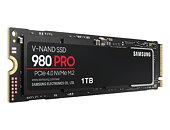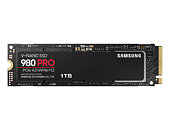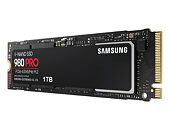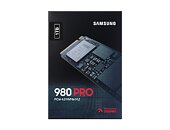Sunday, August 30th 2020

Samsung 980 PRO NVMe SSD Uses TLC NAND Flash with Half the Endurance of 970 PRO: Product Page
Samsung's hotly anticipated 980 PRO M.2 NVMe flagship client-segment SSD is the company's first "PRO" branded SSD to feature TLC NAND flash memory, breaking from a unique tradition of using MLC (2 bits per cell) NAND flash. Product pages of the drive went live, and its specifications clearly state the use of "Samsung V-NAND 3-bit MLC," which is another way of saying TLC. "MLC" generally referred to as NAND flash memory that stores 2 bits per cell, even through the term "Multi-level" is amorphous.
The product page lists other juicy specs of Samsung's first M.2 NVMe client SSD that takes advantage of PCI-Express gen 4. The drive uses Samsung's in-house design "Elpis" controller, which uses NVMe 1.3 protocol over PCI-Express 4.0 x4, and an LPDDR4 DRAM cache. The 980 PRO comes in capacities of up to 1 TB, with up to 1 GB of DRAM cache. Samsung rates the 1 TB version as capable of up to 7000 MB/s sequential reads, up to 5000 MB/s sequential writes, and up to 1 million IOPS 4K random reads/writes at QD32. The use of TLC impacts endurance adversely in comparison to that of the drive's immediate predecessor, the 970 PRO, with the 1 TB 980 PRO warranty covering only up to 600 TBW, in comparison to 1200 TBW of the 970 PRO 1 TB, and the 500 GB 980 PRO offering just 300 TBW warranty coverage in comparison to 600 TBW of the 970 PRO 512 GB.
Source:
th3typh00n (Reddit)
The product page lists other juicy specs of Samsung's first M.2 NVMe client SSD that takes advantage of PCI-Express gen 4. The drive uses Samsung's in-house design "Elpis" controller, which uses NVMe 1.3 protocol over PCI-Express 4.0 x4, and an LPDDR4 DRAM cache. The 980 PRO comes in capacities of up to 1 TB, with up to 1 GB of DRAM cache. Samsung rates the 1 TB version as capable of up to 7000 MB/s sequential reads, up to 5000 MB/s sequential writes, and up to 1 million IOPS 4K random reads/writes at QD32. The use of TLC impacts endurance adversely in comparison to that of the drive's immediate predecessor, the 970 PRO, with the 1 TB 980 PRO warranty covering only up to 600 TBW, in comparison to 1200 TBW of the 970 PRO 1 TB, and the 500 GB 980 PRO offering just 300 TBW warranty coverage in comparison to 600 TBW of the 970 PRO 512 GB.




81 Comments on Samsung 980 PRO NVMe SSD Uses TLC NAND Flash with Half the Endurance of 970 PRO: Product Page
The point, my point is that you can't have it all ~ a drive having chart leading performance, which "lasts" 10 years, is cool to boot & covers itself in glory for everything you throw at it. Even enterprise drives compromise on something. Rated NAND writes are the last thing anyone should worry about on most of these consumer drives, unless you have a specific use case where heavy writes are to be expected. In which case there's better, albeit more expensive alternatives.
My drive has a SLC write cache of about 333GB once that is used up it will hit about 600 mb/s for sustained writes.
However I don't think I've ever written 333GB of data to the drive in one shot is usually much lower so I've never see the performance outside the cache. Other TLC drive have smaller cache and the hit on those will show up sooner.
My main point here is though, "professional" does not need mean "absurdly long lifetime" like it has in the past. But Samsung can and should knock the price down accordingly. I don't have confidence that will happen however.
The Samsung 983 ZET (Z-NAND) SSD Review: How Fast Can Flash Memory Get?Yup here we are, making fantastical claims about how 3d/4d NAND, 96L TLC, 128L TLC, xxL QLC or MLC behave all in a manner which is consistent with your hypothesis devoid of any real world studies to back them up :laugh:
- "I've never claimed anything about (NAND) endurance & temps" - You literally said in post #51 "less heat could mean better endurance" in direct quoted response to what everyone was very obviously comparing (NAND lifespan based on P/E cycles between MLC vs TLC vs QLC). Again, when people do compare drives then it's pretty damn obvious we mean "like for like", not "when doing MLC vs TLC vs QLC P/E based NAND endurance comparisons, let's start counting random controller failures that have zero to do with NAND" or "If I hold a hair dryer up against an MLC drive whilst pointing a fan at the TLC one, that could complicate NAND lifespan comparisons". No sh*t, Sherlock...
- "Wonderful a review from AT" - Dude, that was your own link from your own post #45... :kookoo:
- "Higher endurance consumer MLC doesn't exist, it just so happens that MLC have better endurance. Consumer SSD's are not about endurance at all but performance". Perhaps you better e-mail Samsung and tell them they've gotten their marketing materials wrong considering that "Pro performance and Endurance" has been literally right there at the top of their SSD PRO range pages going back 5 years with the words "designed to handle heavy workloads on workstations and high-end computers with IT heavy users in mind" literally underneath pushing endurance as a primary sales pitch...
Sorry dude but you'll have to find someone else to troll with these mindless "arguing for the sake of arguing" word games. It's pretty obvious who buys MLC drives and your own claims have already been debunked by Samsung's own website in nice big size 64 font. Two people here other than myself have also tried to explain it to you, and if you still can't figure it out, then far from "curing the forum of misinformation", you've ironically ended up the bigger purveyor of it...
en.wikipedia.org/wiki/Flash_memory
Those are general numbers but are accepted as effective standards in the industry. Endurance numbers will vary somewhat from one manufacturer to another.
^Dude you brought up the point about 83C temps for Sk Hynix from the AT review, why are using numbers from Guru3d to compare it to 970 pro! Next you'll tell me pick any random review & compare the numbers from it to any other, for a truly apples to apples comparison you must have a controlled environment wherein the reviewer has used the same system, workload(s) & ideally same ambient temp to test the drives! And let's see the BS you're posting from AT ~So do me a favor, next time you quote me at least read the drivel you've posted first heck I'd be glad if you didn't quote me o_O
Also when you respond to me with statements bring up real life numbers, not something you conjure up in your mind. I'm an authority on everything SSD is not an argument, at least not when you're pretending to ask BS questions (to points which I never made) & answering them yourself!
As for your last point ~ keep the trolling part to a corner where you can deal with it as it seems to be a hobby of yours. I only engaged with you hoping you'd have serious replies, but then looking at your fantastical claims with exactly Zero Facts backing them up I have to say this is not worth my time so Ciao, this is my last reply to you :rolleyes:
I have never come around anyone actually exceeding write cycles = running out of rearranged sectors.
I don't like this, not because of the durability, but because when I buy something that's supposed to transfer stuff at X MB/s, I expect X, not X/10 if I copy large enough file.
That's a bit like saying my VRAM is not fast because once it's exceeded the system RAM is used.
Yeah, you really shouldn’t be commenting on tech boards. This is very basic. To deny it is like trying to argue 2+ 2 = 5
Facts matter. The “endurance” of an ssd drive is 100% correlated to is write cycles and is an extremely important metric for “pros” of all types for whom actual data storage is important.
NAND "endurance" or lifetime writes ~ which are guaranteed by the manufacturer are generally highly conservative for most, if not all consumer drives. You're likely to encounter an issue with the firmware &/or controller than simply running out of P/E cycles. There are no long term studies demonstrating how modern 3D NAND (or SSD) is affected by temps or indeed the usage pattern of users ~ your internet surfing grandparents or what some call themselves "power" users! TLC is a proven tech & is about just as "reliable" as MLC which is to say that your drive will not "wear" itself out just because it's TLC instead of MLC unless you're doing some atypical "server grade" writes. For 90% consumer workload TBW ratings are meaningless, the last 10% ~ are you sure it isn't the temps or firmware/controller that killed your drive instead of it exhausting its P/E cycles? If you can't answer that with any authority you have no right claiming whatever's being peddled in the last few pages!
And lastly here's the P/E numbers from the the first consumer 3D NAND drives, unlike the poster who's just making things up here's the facts ~The 1000 P/E cycles numbers are for QLC & even there you won't find latest gen QLC P/E cycles being listed by SSD makers because they aren't relevant for most consumer workloads. Modern multi layer NAND are way more resilient than typical NAND, especially the TLC kind. So next time when challenging someone on facts, better find something other than alternate facts :toast:
What this thread & forum needs is people updating their knowledge & definitely not trying to sound obnoxiously like they know everything about NAND or SSD's just because they see ZOMG only half the TBW writes :rolleyes:Next time you suggest something like that, at least have the decency go through the entire thread not just the last few replies!
Apply that same thought process to this thread topic and the same mentality fit well here. Samsung is pushing TLC as a professional product because that want to make more money from a product that cost less to make. Granted, to there credit, their latest iteration of TLC 3DNAND has some improvements. However, it is still no comparison to the longevity of MLC and SLC. TLC has no place in professional and prosumer devices, especially at the prices being asked.